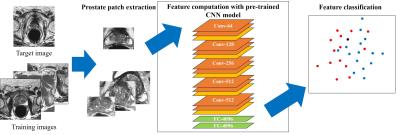3978
Deep Learning Feature Classification for Predicting Treatment Decision: A Preliminary Study on Prostate Cancer PatientsHansang Lee1 and Junmo Kim1
1School of Electrical Engineering, KAIST, Daejeon, Korea, Republic of
Synopsis
We investigated the novel problem of predicting treatment decision for cancer patients using imaging feature analysis. We implemented deep learning feature classification framework consisting of feature computation with deep convolutional neural network (CNN) model and k-nearest neighbor (kNN) feature classification. The preliminary study on TCIA prostate cancer T2 MRI database showed the promising results and the potential of future researches.
Purpose
Radiomic feature analysis and classification approaches have been widely studied for various clinical applications including cancer diagnosis and genotype analysis. In addition to diagnostic and prognostic tasks, treatment decision and surgical planning are also important clinical tasks which can be assisted by radiomic analysis approaches. To investigate the potential of applying feature analysis to the treatment decision problem, deep learning feature classification for predicting the treatment decision in prostate cancer patients was presented.Methods
From The Cancer Imaging Archive (TCIA),1 the public database PROSTATE-DIAGNOSIS2 was used. The database includes T1- and T2w MRIs of prostate cancer patients, with biopsy, tissue, and radiology reports provided for number of subjects. We selected fifteen patients with T2w MRI, prostate segmentation labels of the central gland and peripheral zone, diagnostic reports with treatment decisions provided. For selected patients, T2w MRIs were acquired on a 1.5T Philips Achieva system. All scans have voxel size of 0.4mm x 0.4mm x 3.0mm, TR of 3849 ms, and TE of 120 ms. The database provides prostate segmentation labels in central gland and peripheral zone for all scans, and biopsy, tissue, and MRI radiology reports are also provided. From these reports, we used information of treatment decision, by transforming written sentences into one of the labels; radiation therapy (0) or surgery (1). Our problem is to predict the binary label of treatment decision, based on T2w MRIs and prostate segmentation labels, using image feature classification. We implemented deep learning feature classification framework, consisting of (1) prostate patch extraction, (2) feature computation with deep convolutional neural network (CNN) model, and (3) feature classification with k-nearest neighbor (kNN) classifier. (Fig. 1) In prostate patch extraction, an image patch for each MRI scan was extracted by the bounding box of prostate segmentation labels. In feature computation, the VGGNet CNN model3 pre-trained with ImageNet database was used to generate the features of 4,096 dimension from the input image patches. In feature classification, kNN classifier was trained with the features of training examples and was applied to the unseen test features, to classify them into one of the treatment decision labels.Results
Fifteen patients were included in this study and experiments were cross-validated by leave-one-out method. Classification results were quantitatively assessed by error rates. We compared the results of our approach with those of deep learning feature classification without patch extraction, which use whole scan as an input for CNN model. In experiments, our approach with patch extraction achieved the error rate of 40%, while our approach without patch extraction achieved the error rate of 46.67%. It can be observed that the proposed approach showed promising results of 60% accuracy, in predicting the treatment decision using image feature classification. It also can be observed that the patch extraction can make our classification system to focus on the region of interest and improve its accuracy by 6.67%p. Future works will include not only use of large scale database with multi-modal images, but also extended use of radiomic features in addition to deep learning features, to improve the performance of our approach and to provide extensive statistical analysis on experimental results..Conclusions
A preliminary study on novel task of predicting cancer treatment decision with image feature classification was investigated. We implemented deep learning feature classification system combining deep CNN feature computation and kNN feature classification. In preliminary experiments on public cancer imaging database for prostate cancer patients, we obtained promising results of predicting surgical decision based on prostate T2 MRI patch and the proposed classification framework. Future works will focus on extended investigation of the problem and further statistical evaluation and experimental validation.Acknowledgements
No acknowledgement found.References
[1] Clark K, Vendt B, Smith K, Freymann J, Kirby J, Koppel P, Moore S, Phillips S, Maffitt D, Pringle M, Tarbox L, Prior F. The Cancer Imaging Archive (TCIA): Maintaining and Operating a Public Information Repository, Journal of Digital Imaging, Volume 26, Number 6, December, 2013, pp 1045-1057. [2] Bloch, B. Nicolas, Jain, Ashali, & Jaffe, C. Carl. (2015). Data From PROSTATE-DIAGNOSIS. The Cancer Imaging Archive. [3] Simonyan, K. and Zisserman. A. Very deep convolutional networks for large-scale image recognition. arXiv preprint arXiv:1409.1556, 2014.Figures

Fig.
1. Outline of the proposed
approach on T2 MRI feature classification for prostate cancer treatment decision
prediction. The approach includes (1) prostate patch extraction with manual
prostate labels, (2) feature computation using pre-trained deep CNN model, and
(3) feature classification by training kNN classifier.